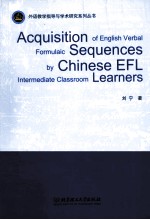

Acquisition of English Verbal Formulaic Sequences by Chinese EFL Intermediate ClPDF电子书下载
- 电子书积分:9 积分如何计算积分?
- 作 者:刘宁著
- 出 版 社:北京:北京理工大学出版社
- 出版年份:2012
- ISBN:9787564062613
- 页数:156 页
Introduction 1
Chapter One:Acquisition of Formulaic Sequences 11
1.1 First Language(L1)Acquisition of Formulaic Sequences 11
1.2 Second Language(L2)Acquisition of Formulaic Sequences 14
Chapter Two:The Nature of Formulaic Sequences and How to Learn and Teach Them 19
2.1 The Holistic and Analytic Features of Formulaic Sequences 19
2.2 The Transparency and Opaqueness of Formulaic Sequences 21
2.3 The Fixedness of Formulaic Sequences 24
2.4 The Processing of Formulaic Sequences 31
2.5 The Input of Formulaic Sequences for L2 Learners 35
2.6 Vocabulary Knowledge and Formulaic Sequences 37
2.6.1 What Is a Word? 37
2.6.2 What Does It Mean to Know a Word? 39
2.6.3 Measurement of Vocabulary Knowledge 44
2.6.4 Vocabulary Knowledge and Formulaic Sequences 50
2.7 Structural Differences Between English and Chinese Verbal Formulaic Sequences 50
2.8 The Effect of Classroom Instruction on the Acquisition of Formulaic Sequences 52
2.9 Overall Language Proficiency and Formulaic Sequences 55
2.10 Individual Differences and the Acquisition of Formulaic Sequences 56
Chapter Three:Study Questions and Methodology 58
3.1 Hypotheses for the Present Study and Their Operationalisations 58
3.2 Methodology 60
3.2.1 Participants 60
3.2.2 Instruments and Procedures 62
3.2.2.1 Identifying the Target Verbal Formulaic Sequences 62
3.2.2.2 The English Verbal Formulaic Sequences Pre-test,Post-test and Training Test 64
3.2.2.3 The Vocabulary-size Pre-test and Post-test 65
3.2.2.4 The Questionnaire 66
3.2.2.5 Survey of the Semantic Transparency/Opaqueness of the 100 Target English Verbal Formulaic Sequences 66
3.2.2.6 The Class Observations 68
3.2.2.7 The Participants' Essays 68
3.2.2.8 Survey of the Exposure to the 100 Target English Verbal Formulaic Sequences 70
Chapter Four:Data Analyses 71
4.1 Data Analyses for the Questionnaire 71
4.1.1 The Participants' Knowledge of English Verbal Formulaic Sequences 71
4.1.2 The Participants' Report on Their Use of English Verbal Formulaic Sequences 72
4.1.3 The Input of English Verbal Formulaic Sequences for the Participants 73
4.1.4 The Output of English Verbal Formulaic Sequences of the Participants 74
4.1.5 Summary 75
4.2 Group Differences in Overall Proficiency,Vocabulary Size and the Mastery of English Verbal Formulaic Sequences 76
4.2.1 Group Differences in Overall English Language Proficiency 76
4.2.2 Group Differences in Vocabulary Size 76
4.2.2.1 The Vocabulary-size Pre-test 76
4.2.2.2 The Vocabulary-size Post-test 77
4.2.2.3 The Vocabulary Size Increase 77
4.2.3 Group Differences in the Mastery of English Verbal Formulaic Sequences 78
4.2.3.1 The English Verbal Formulaic Sequences Pre-test 79
4.2.3.2 The English Verbal Formulaic Sequences Post-test 79
4.2.3.3 The English Verbal Formulaic Sequences Training Test 80
4.2.3.4 Increase in the Mastery of English Verbal Formulaic Sequences 80
4.3 Relationship Between Vocabulary Size and the Mastery of English Verbal Formulaic Sequences 81
4.4 Relationship Between Overall English Proficiency and the Mastery of English Verbal Formulaic Sequences 82
4.5 Relationship Between the Semantic Transparency and the Mastery of English Verbal Formulaic Sequences 83
4.6 Relationship Between Input Frequency and the Mastery of English Verbal Formulaic Sequences 90
4.6.1 Textbook Input Frequency and the Mastery of English Verbal Formulaic Sequences 90
4.6.2 Explicit Classroom Instructions and the Mastery of English Verbal Formulaic Sequences 91
4.7 Relationship Between the Participants' General Vocabulary Knowledge and the Mastery of English Verbal Formulaic Sequences 93
Chapter Five:Findings and Discussion 95
5.1 Major Findings 95
5.2 Discussion 100
5.3 Limitations 101
APPENDICES 102
Appendix Ⅰ:The 50 Most Frequent Verbs of the English Language 102
Appendix Ⅱ:The Top-10 Verbs with Their Instances in College English Curriculum Requirements(CECR) 104
Appendix Ⅲ:The 100 Target English Verbal Formulaic Sequences 105
Appendix Ⅳ:The Final 100 Target English Verbal Formulaic Sequences in Sentence-length Contexts 109
Appendix Ⅴ:The English Verbal Formulaic Sequences Pre-test and Post-test 114
Appendix Ⅵ:The English Verbal Formulaic Sequences Training Test 119
Appendix Ⅶ:The Vocabulary-size Pre-test and Post-test 127
Appendix Ⅷ:The Questionnaire 129
Appendix Ⅸ:The Transparency/Opaqueness Survey of the 100 Target English Verbal Formulaic Sequences 132
Appendix Ⅹ:The Textbook Input Frequency of the 100 Target English Verbal Formulaic Sequences 137
References 141
- 《中风偏瘫 脑萎缩 痴呆 最新治疗原则与方法》孙作东著 2004
- 《水面舰艇编队作战运筹分析》谭安胜著 2009
- 《王蒙文集 新版 35 评点《红楼梦》 上》王蒙著 2020
- 《TED说话的力量 世界优秀演讲者的口才秘诀》(坦桑)阿卡什·P.卡里亚著 2019
- 《燕堂夜话》蒋忠和著 2019
- 《经久》静水边著 2019
- 《魔法销售台词》(美)埃尔默·惠勒著 2019
- 《微表情密码》(波)卡西亚·韦佐夫斯基,(波)帕特里克·韦佐夫斯基著 2019
- 《看书琐记与作文秘诀》鲁迅著 2019
- 《酒国》莫言著 2019
- 《大学计算机实验指导及习题解答》曹成志,宋长龙 2019
- 《指向核心素养 北京十一学校名师教学设计 英语 七年级 上 配人教版》周志英总主编 2019
- 《大学生心理健康与人生发展》王琳责任编辑;(中国)肖宇 2019
- 《大学英语四级考试全真试题 标准模拟 四级》汪开虎主编 2012
- 《大学英语教学的跨文化交际视角研究与创新发展》许丽云,刘枫,尚利明著 2020
- 《北京生态环境保护》《北京环境保护丛书》编委会编著 2018
- 《复旦大学新闻学院教授学术丛书 新闻实务随想录》刘海贵 2019
- 《大学英语综合教程 1》王佃春,骆敏主编 2015
- 《大学物理简明教程 下 第2版》施卫主编 2020
- 《指向核心素养 北京十一学校名师教学设计 英语 九年级 上 配人教版》周志英总主编 2019
